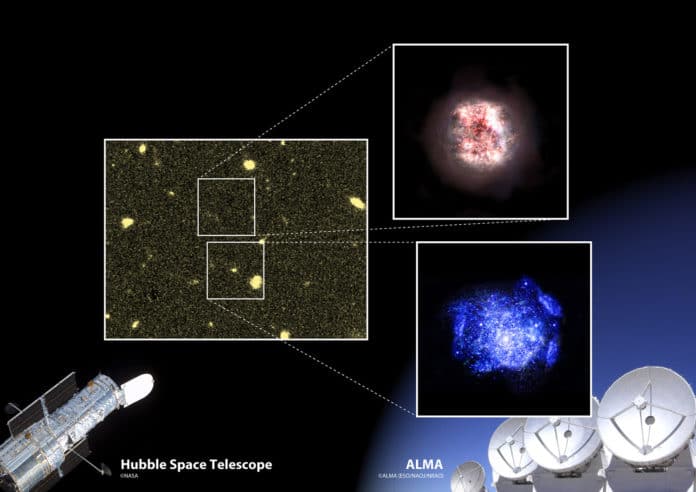To construct accurate and consistent astrophysics models, it is essential to study and understand the early Universe. Model of the early Universe would help scientists identify all the galaxies in the first billion years of cosmic history.
While investigating the data of young, distant galaxies observed with the Atacama Large Millimeter/submillimeter Array (ALMA), astronomers from a global research team called REBELS (Reionization-Era Bright Emission Line Survey, astronomers detected unexpected emissions coming from seemingly empty regions in space.
Further observations revealed that the emissions were coming from two hitherto undiscovered galaxies heavily obscured by cosmic dust.
Co-author Dr. Elisabete da Cunha, a researcher based at The University of Western Australia node of the International Centre for Radio Astronomy Research (ICRAR), said, “These unprecedented observations of galaxies in the very early Universe show that by looking for young galaxies in the ultraviolet to optical range we might have been missing a significant population of dust-obscured galaxies.”
“These galaxies can only be detected in the infrared/sub-millimeter domain, where interstellar dust grains shine. This can have profound implications for our census of primeval galaxies and their star formation, and also tells us that dust grains from very early on and have to be accounted for when we study even the most distant galaxies.”
This discovery suggests that numerous such galaxies might still be hidden in the early Universe, many more than researchers expected.
Lead author Dr. Yoshinobu Fudamoto, from Waseda University and the National Astronomical Observatory in Japan said, “What is most surprising about this serendipitous finding is that the newly discovered galaxies, which formed more than 13 billion years ago, are not strange at all when compared with typical galaxies at the same epoch. These new galaxies were missed not because they are extremely rare, but only because they are completely dust-obscured.”
“However, it is uncommon to find such ‘dusty’ galaxies in the early period of the Universe (less than 1 billion years after the Big Bang), suggesting that the current census of early galaxy formation is most likely incomplete and would call for deeper, blind surveys. “It is possible that we have been missing up to one out of every five galaxies in the early Universe so far.”
Journal Reference:
- Fudamoto, Y., Oesch, P.A., Schouws, S. et al. Normal, dust-obscured galaxies in the epoch of reionization. Nature 597, 489–492 (2021). DOI: 10.1038/s41586-021-03846-z
